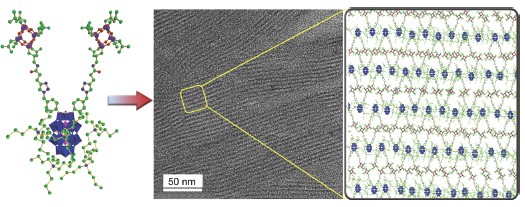| [1] Gómez-Romero, P.; Sanchez, C. Functional Hybrid Materials, Wiley-VCH, Weinheim, 2006.[2] Kickelbick, G. Hybrid Materials: Synthesis, Characterization, and Applications, Wiley-VCH, Weinheim, 2007.[3] Clément, S.; Kenneth, J. S.; Susumu, K. Chem. Soc. Rev. 2011, 40, 471.[4] Sanchez, C.; Julián, B.; Belleville, P.; Popall, M. J. Mater. Chem. 2005, 15, 3559.[5] Zhang, Z. L.; Horsch, M. A.; Lamm, M. H.; Glotzer, S. C. Nano Lett. 2003, 3, 1341.[6] Glotzer, S. C.; Horsch, M. A.; Iacovella, C. R.; Zhang, Z. L.; Chan, E. R.; Zhang, X. Curr. Opin. Colloid Interface Sci. 2005, 10, 287.[7] Šari?, A.; Bozorgui, B.; Cacciuto, A. J. Phys. Chem. B 2011, 115, 7182.[8] Filion, L.; Marechal, M.; Oorschot, B. V.; Pelt, D.; Smallenburg, F.; Dijkstra, M. Phys. Rev. Lett. 2009, 103, 188302.[9] Pradeep, C. P.; Misdrahi, M. F.; Li, F. Y.; Zhang, J.; Xu, L.; Long, D. L.; Liu, T. B.; Cronin, L. Angew. Chem., Int. Ed. 2009, 48, 8309.[10] Han, Y. K.; Xiao, Y.; Zhang, Z. J.; Liu, B.; Zheng, P.; He, S. J.; Wang, W. Macromolecules 2009, 42, 6543.[11] Hu, M. B.; Xia, N.; Yu, W.; Ma, C.; Tang, J.; Hou, Z. Y.; Zheng, P.; Wang, W. Polym. Chem. 2012, 3, 617.[12] Landsmann, S.; Lizandara-Pueyo, C.; Polarz, S. J. Am. Chem. Soc. 2010, 132, 5315.[13] Landsmann, S.; Wessig, M.; Schmid, M.; Cölfen, H.; Polarz, S. Angew. Chem., Int. Ed. 2012, 51, 5995.[14] Hu, M. B.; Hou, Z. Y.; Xiao, Y.; Yu, W.; Ma, C.; Ren, L. J.; Zheng, P.; Wang, W. Langmuir 2013, 29, 5714.[15] Wang, X. L.; Wang, Y. L.; Miao, W. K.; Hu, M. B.; Tang, J.; Yu, W.; Hou, Z. Y.; Zheng, P.; Wang, W. Langmuir 2013, 29, 6537.[16] Yu, X. F.; Zhong, S.; Li, X. P.; Tu, Y. F.; Yang, S. G.; Van Horn, R. M.; Ni, C. Y.; Pochan, D. J.; Quirk, R. P.; Wesdemiotis, C.; Zhang, W. B.; Cheng, S. Z. D. J. Am. Chem. Soc. 2010, 132, 16741.[17] Li, Y.; Zhang, W. B.; Hsieh, I.; Zhang, G. L.; Cao, Y.; Li, X. P.; Wesdemiotis, C.; Lotz, B.; Xiong, H. M.; Cheng, S. Z. D. J. Am. Chem. Soc. 2011, 133, 10712.[18] Sun, H. J.; Tu, Y. F.; Wang, C. L.; Van Horn, R. M.; Tsai, C. C.; Graham, M. J.; Sun, B.; Lotz, B.; Zhang, W. B.; Cheng, S. Z. D. J. Mater. Chem. 2011, 21, 14240.[19] Yu, X. F.; Zhang, W. B.; Yue, K.; Li, X. P.; Liu, H.; Xin, Y.; Wang, C. L.; Wesdemiotis, C.; Cheng, S. Z. D. J. Am. Chem. Soc. 2012, 134, 7780.[20] Polyoxometalate Chemistry: From Topology via Self-Assembly to Applications, Eds.: Pope, M. T.; Müller, A., Springer, Netherlands, 2001.[21] Special thematic issue on polyoxometalates: Chem. Rev. 1998, 98, 1–388.[22] Proust, A.; Thouvenot, R.; Gouzerh, P. Chem. Commun. 2008, 1837.[23] Dolbecq, A.; Dumas, E.; Mayer, C. R.; Mialane, P. Chem. Rev. 2010, 110, 6009.[24] Proust, A.; Matt, B.; Villanneau, R.; Guillemot, G.; Gouzerh, P.; Izzet, G. Chem. Soc. Rev. 2012, 41, 7605.[25] Marcella, B.; Mauro, C.; Gianfranco, S.; Alessandro, B. Adv. Synth. Catal. 2004, 346, 648.[26] Cordes, D. B.; Lickiss, P. D.; Rataboul, F. Chem. Rev. 2010, 110, 2081.[27] Tanaka, K.; Chujo, Y. J. Mater. Chem. 2012, 22, 1733.[28] Odobel, F.; Severac, M.; Pellegrin, Y.; Blart, E.; Fosse, C.; Cannizzo, C.; Mayer, C. R.; Elliott, K. J.; Harriman, A. Chem. Eur. J. 2009, 15, 3130.[29] Contant, R.; Klemperer, W. G.; Yaghi, O., In Inorganic Syntheses, Mc Graw-Hill, New York, 1990, Vol. 27, p. 104.[30] Kolb, H. C.; Finn, M. G.; Sharpless, K. B. Angew. Chem., Int. Ed. 2001, 40, 2004.[31] Hamley, I. W. The Physics of Block Copolymers, Oxford University Press, Oxford, 1999. |
